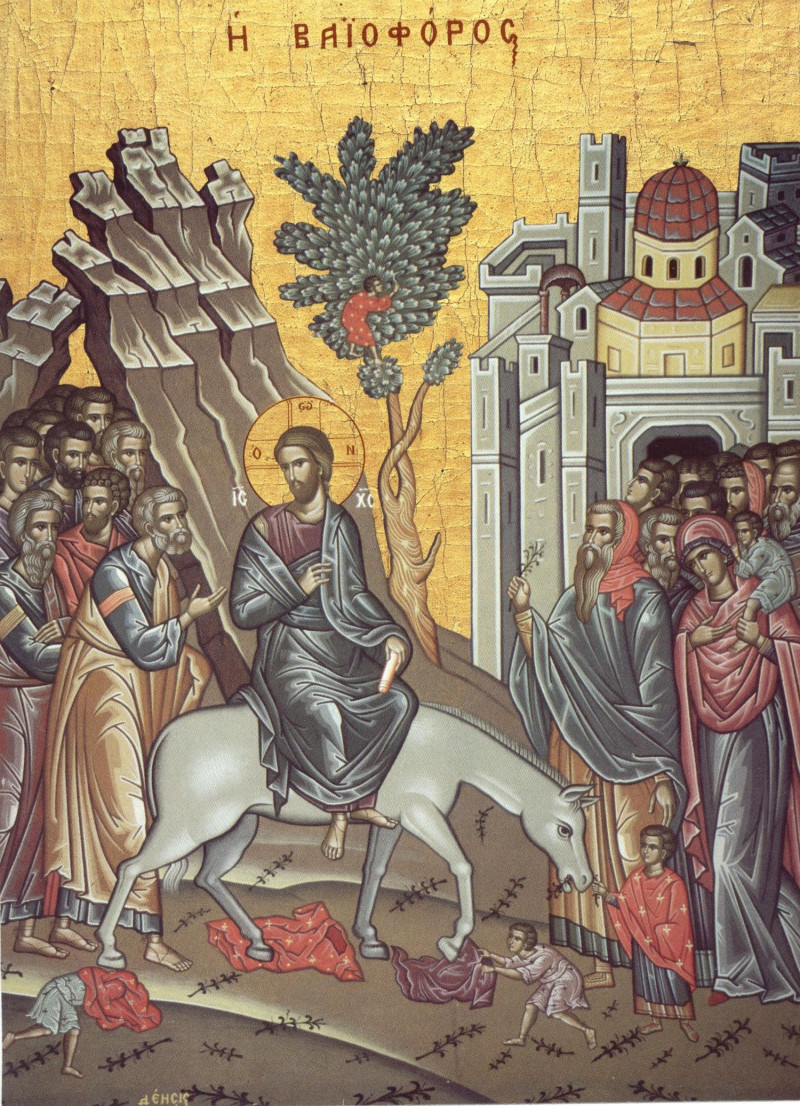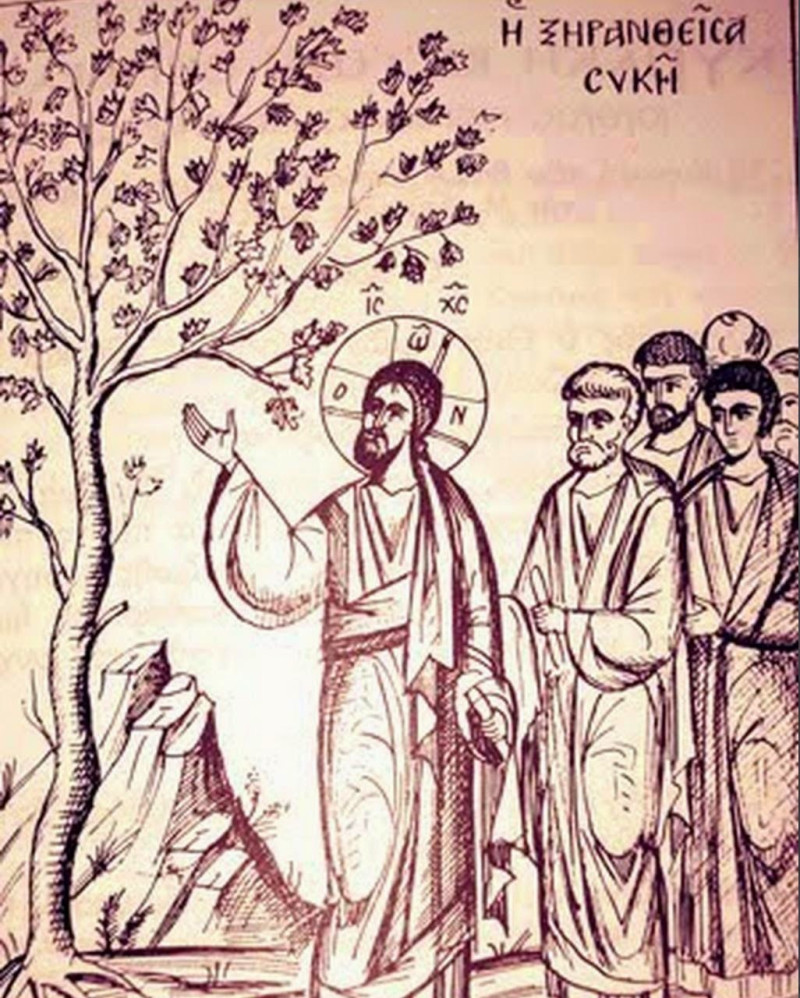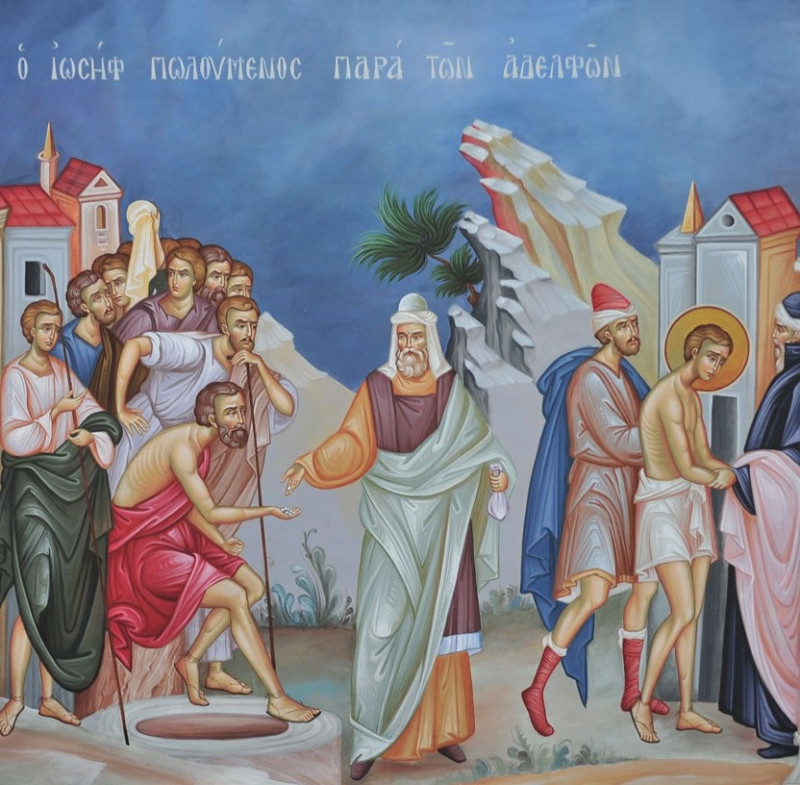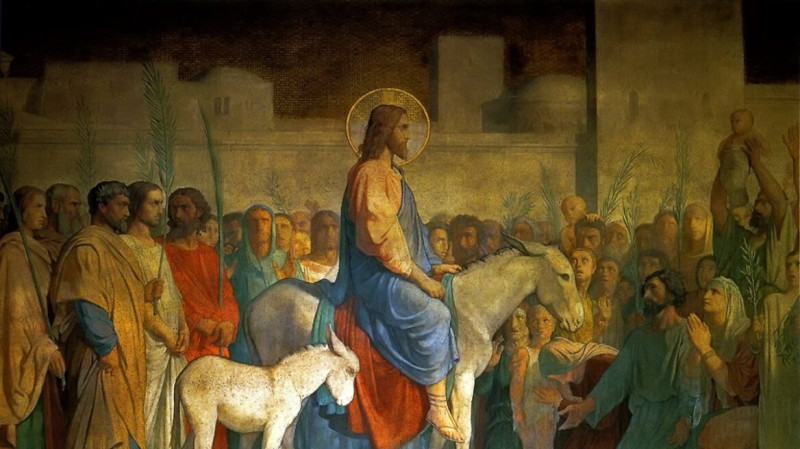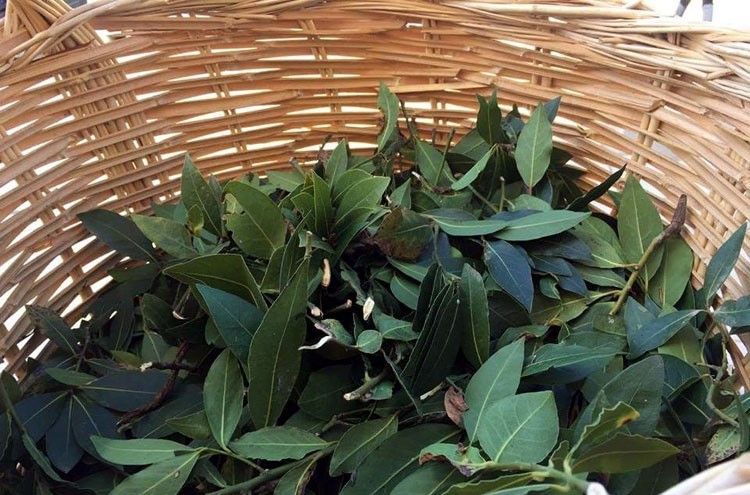At we will give the “stamp” of the day for the entire Holy Week until Easter Sunday
By Marina Zioziou
Holy Week it is something unique in the church year. In the importance, after all, of world-saving events, according to the saint John the Chrysostom, due to the name of the most holy week of the year as “Great”.
In the liturgical act of the Church, the beginning of the next day is made from the afternoon of the previous one. So, the Masses held on the evening of Holy Week, concern the events of the following day. Our texts, following this practice, will describe the next day’s events, but will be in the Sequence of the day they are published.
The “curtain” of Holy Week opens today, the Palm Sunday in the afternoon, with “Sequences of the Bridegroom”. More specifically, the Church, so that – as much as possible – more believers could participate in the Masses, allowed the Orthros of each day (the morning Mass of each day, which summarizes its meaning), to be sung in the afternoon of the previous one.
Every day on –with the help of Archimandrite Fr Filoumenos Roubis, general secretary of the Holy Archdiocese of Athens– we will give the “stamp” of the day for the entire Holy Week until Easter Sunday. Also, Mrs. Evelena Kardamila, PhD candidate in Folklore will “travel” us to customs and traditions in every corner of Greece, which have their roots deep in time.
Palm Sunday in the morning, our Church experiences the triumphal entry of Christ into Jerusalem, composing a joyful foreshock to the painful humiliations that will follow.
The facts are as follows: Six days before the Passover (the Passover was a seven-day festival commemorating the Exodus of the Jews from Egypt and the passage to the Promised Land), Christ sends two of His disciples, telling them; “go to the opposite village, and as you enter, you will find a colt tethered, on which no man has ever sat. Solve it and bring it here. And if anyone asks you, why do you solve it? You will answer him that the Lord needs it”. So it happened. They brought it to Jesus and after throwing their outer garments on Him, they helped Him up.
Because of the feast, many people had gathered in Jerusalem. When the coming of Christ was known, they took it in hand “the woes of the palm trees” and they went out to meet Him, shouting: “Hosanna, blessed is he who comes in the name of the Lord, the king of Israel.” A few days earlier (we celebrate it the day before), Christ had raised Lazarus in Bethany. This fact, to be resurrected four days dead and even buried, had been preached in Israel immediately. People believed that God would perform some miracle that would change their unbearable situation. And this despite the iron fist of Rome that oppressed them and despite the corruption and pettiness of the elders.
So there was a custom in ancient times, when a king entered a city, he entered on horseback, in a chariot, with retinue and retinue, displaying his valor, greatness and glory. That is why the crowds that day cheered. They cheered the entry into Jerusalem of someone who they believed would solve their problems, their political, social, cultural – even personal – problems. They clamored for the entry of one who would liberate their nation and re-establish a theocratic and theo-centered state.
In our Church on this day we share the “bad things”
According to Archimandrite Fr Filoumenos Roubis, for the Church, this “messianic hero”, as the masses understood him, did not exist. Indeed, we cheer and cheer “blessed is he who comes in the name of the Lord”but the content of these words is different from that of the people who welcomed Jesus Christ then, that first “Palm Sunday”. They expected victory – visible and obvious victory. We await death – a martyr’s death.
In our Church on this day we share the “bad things”. While the vaiahs the Israelites held were palm branches (probably date palms), we distribute laurel or myrtle branches. With the transfer of Christianity to other peoples, the custom was spread and adapted according to the flora of each region. They chose – probably – these plants as more similar to palm trees, since on the one hand they are evergreen, on the other hand they have a pleasant aroma. This custom seems to have been established as early as the 9th century. In the early Christian years, in Jerusalem, the bishop entered the city “on a horse”, representing the event, while in Byzantine times, it was “the emperor’s walk”, from the Palace to the Great Church. On this route, the emperor was handing out wreaths and crosses to the people, and the Patriarch was handing out crosses and candles.
Palm Sunday afternoon – Holy Monday Orthros
On the afternoon of Palm Sunday, the scene changes. The Orthros of the following day (Great Monday) is chantedthat’s why the atmosphere, from triumphantly festive, turns into overwhelmingly mournful. After the Sixth Psalm, the well-known and beloved Troparion “Behold the Bridegroom comes” is sung three times.. The lights are off and in the darkness the image of Christ as the Bridegroom is enshrined, which will be placed in worship for three days. That is why the first three days of Holy Week constitute a liturgical unity and are referred to in the language of the faithful as “the sequences of the Bridegroom” or simply “Bridegroom”.
The image of the Bride usually represents Christ busted, with a crown of thorns on the head, leaning slightly to the right, the hands, tied, hold the sarcastic reed, while a red chlamys covers one shoulder, leaving the other bare. Christ is presented as a Bridegroom, that is, as a bridegroom. Christ Himself often likened His coming to a wedding and Himself to a Bridegroom. And at the end of the Apocalypse heaven is symbolized by a “city adorned as a bride,” into which nothing evil enters.
The importance of this simile lies in the fact that in the person of Christ a “holy marriage” of God and humanity takes place: in marriage the two spouses are united, while in Christ God and man were united, therefore Christ is God-man. That is why Christ is called the “Bridegroom of the Church”, the androgynous relationship is likened by the apostle Paul to the relationship between Christ and the Church (in the letter to the Ephesians, ch. 5, which is read during the wedding ceremony), while the “Song Asmaton” (the love song of King Solomon found in the Old Testament) was interpreted by the Christian saints as an allegory of the love between God and man.
- In the Synaxari of Great Monday there is a reference to Pagalos Joseph, a person of the Old Testament. Of him we read in Genesis chapters 37-50. It is a foreshadowing of Christ, because He, beloved son of the Father, was envied by His fellow Jews, sold by His disciple for thirty pieces of silver and closed in the dark pit, the grave.
- Also, today we commemorate the fruitless fig tree, which the Lord cursed and withered immediately. This incident is reenacted on Holy Monday morning, at the Presanctified Divine Liturgy. The fruitless fig tree, according to the interpretation of the Holy Fathers. It symbolizes both the Synagogue of the Jews, which had no spiritual fruits, and every person who lacks spiritual fruits, that is, virtues. The evangelist Mark reports that when the Lord cursed the fig tree and it dried up, its green leaves immediately fell and the next day its root also dried up.
The customs of our place – The decoration of the churches
According to Mrs. Evelena Kardamila, the most characteristic custom in the feast of the Palms, both for the traditional and for the modern society, is the decorating churches with palm leaves and distributing laurel to the congregation. In many areas the palm leaves are given various shapes such as crosses, moons and stars and then the church they are placed as amulets in the iconostasis of the houses.
In traditional society, the preparation of the church decoration was undertaken from the previous day by newly married girls or newly married couples with the expectation that the fertilizing power contained in the branches would be transferred to them. In Epirus, for example, as many girls were married during the year, they wore green dresses and red tsaruchias and accompanied by their female relatives went to church in the morning. After worshiping all the images, they each rang the bell once.
On the other hand in Mani and Thrace the newly married couples went to the church together and even believed that whichever couple arrived first, would soon have a son. In other regions of Greece, such as Laconia, on Palm Sunday, the “slappings” took place. After the end of the liturgy, the women who wanted to give birth during the year, lightly hit each other with the laurel branches that the priest had previously distributed to them.
According to popular belief, the fertilizing power of vagia was not only transmitted to humans, but also to anything else that bore fruit, such as animals and plants. For this reason in many areas, such as Skyroswith the scraps they took from the church, they then rested their animals and then placed them on their trees so that they would bear fruit.
At the same time, the traditional society attributed healing power, as well as deterrent power for all evil, to the vagaries. Thus in areas such as the coasts of Asia Minor and Lesvosafter church school, groups of children would take the bread and distribute it from house to house singing “Vaya, vaya to Vayo eat fish and kolio and the next Sunday they eat a red egg”. This celebration of the children with branches of the bay tree has its basis in the ancient Greek spring festivals, during which the children, holding branches decorated with fruits, went around the streets singing wishes for a good harvest.
Finally, amidst all the happy atmosphere of church decorations and young people’s feasts, the celebration of Jesus’ triumphal entry into Jerusalem is completed with the relaxation of fasting, since on this day it is customary to kill the fish on the festive table.
Source: Skai
I have worked as a journalist for over 10 years, and my work has been featured on many different news websites. I am also an author, and my work has been published in several books. I specialize in opinion writing, and I often write about current events and controversial topics. I am a very well-rounded writer, and I have a lot of experience in different areas of journalism. I am a very hard worker, and I am always willing to put in the extra effort to get the job done.


